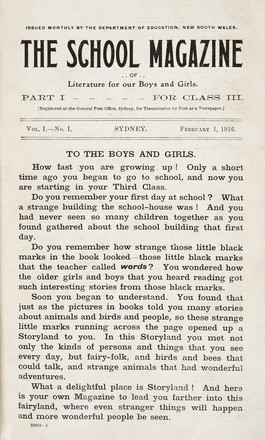The School Magazine is well-known to generations of those who
attended primary school in New South Wales. Commenced in 1916 – whilst
Australia and the world was at war – the magazine was intended to give school
children their own reading material – a monthly publication full of stories,
history, songs, poems, illustrations and plays.
The magazine was established by Stephen Henry Smith (1865–1943) whilst
Smith was employed by the Department of Education as an inspector of
continuance schools. Smith worked on the magazine until Doris Chadwick was
employed as editor in 1922, a post she held until 1949 (however until this time
she was only ever listed as ‘Assistant Editor’ by the Department, despite being
the magazine’s sole employee).
In the earlier decades of the magazine, themes of nationalism, good
citizenship and devotion to the British Empire were prevalent. Non-fiction
articles commonly focused on the exploration of the new world and the feats of
‘brave’ and ‘wise’ men, and generally centred around grand themes in history
and geography, whilst fiction articles ranged from fantastical fairy stories to
abridged versions of the classics such as Robinson
Crusoe. The magazine was designed to supplement the reading material
available through New South Wales public schools, and was intended to be
entertaining as well as educational. With such a broad readership, it is
understandable that the magazine often had to take the ‘middle road’ – skirting
the fine line between conservative and controversial.
In 1977, furore erupted over a School Magazine article entitled ‘You
work it out: How do you feel?’, published in the March edition. The article
outlined differing opinions on drug use, asking students to make up their own
minds about the issue. Marijuana use amongst young people was an issue hotly devated
in the media at the time. Written for students in their final year of primary
school, the article included statements such as “…you see people who use
marijuana every now and then. They use it to relax and feel nice, and because
they enjoy it, just as other people have a glass of wine with their meals.
They’re not addicted to it, and it doesn’t stop them doing the things they want
to do.” The article, by assistant editor Joanne Horniman, angered officials in
the NSW Department of Education, and both Horniman and the magazine’s editor,
Lilith Norman, were temporarily suspended whilst an official inquiry was
undertaken. The then Leader of the Opposition, Sir Eric Wallis, lay blame with
the government of the time. Sydney Morning Herald reported Wallis as being
“saddened by not surprised at the article which amounted to an endorsement of
drug taking by juveniles…the Labor government [have] created a climate which
led increasing numbers of people to believe that it was pursuing a soft line on
drugs, prostitution, homosexuality and vagrancy.”
The NSW Department of Education instructed teachers to tear out the
three offending pages. Luckily, the Library’s copy remains intact. It is hardly
surprising that a magazine designed for a primary school aged audience would
attract the judgement and criticism of parents, teachers and the broader
community – each with their own opinion on the correct way to introduce young
people to social issues. The magazine never turned away from the pressing
issues of the day, and published on a wide range topics such as immigration,
war, animal rights and social inequality – with the intention of presented
balanced information, so children could work out their own opinion.
The School Magazine also provided a balance between issues and
imagination – each edition contained fictional stories, poems and
illustrations, as well as the more serious articles and history pieces. And it is
indeed these stories, and their illustrations, that many readers remember most
fondly when they recall The School
Magazine. The State Library of NSW collection contains original artwork
from the magazine, by illustrators Sheila Hawkins, Pamela Allen and Gaye
Chapman, as well as the archives of regular contributors such as children’s
author Pixie O’Harris, who both wrote stories and illustrated them. Many authors
- Robin Klein for example – got stories published in The School Magazine in the early parts of their careers – and went
on to become prolific in the world of children’s literature.
The Library holds the full run of The
School Magazine – from its humble black and white beginnings in 1916,
through to the four-part, full-colour magazine that is produced today. In 1983
the magazine’s four parts (for the four levels Years 3, 4, 5 and 6) were
renamed Countdown, Blast Off, Orbit and
Touchdown. In 1985 it became a two
colour publication and then full-colour in 1999. But perhaps the biggest change
has been in its distribution – in 1993 the magazine became a subscription-based
(fee paying) service, rather than being given to all NSW school students free
of charge as it was in the beginning. Nevertheless, the subscription service
has expanded the geographic reach of the magazine, and it is now purchased by
schools in all Australian states and territories.
The School Magazine has always published up and coming writers and
illustrators, and it continues to welcome unsolicited manuscripts from across
the world. It is significant not only for what it has meant for generations of
young readers, but also countless writers and artists who found in it an outlet
for their words and ideas.



 Back to list
Back to list